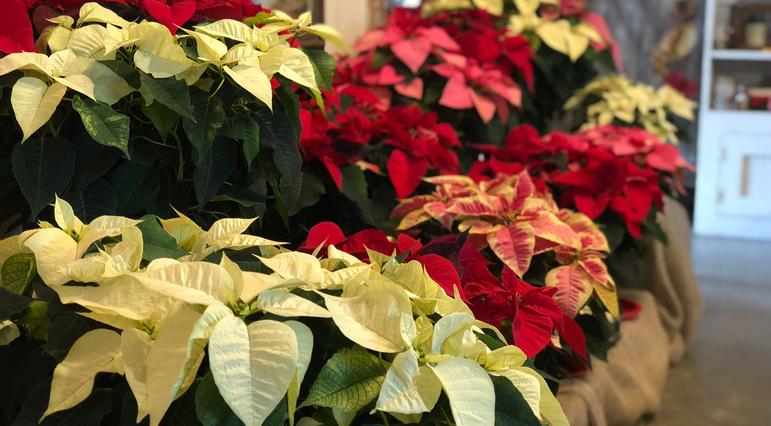Poinsettias

Colorful poinsettias.
In the plant kingdom nothing says Merry Christmas better than the Poinsettia! Maybe it’s the bright red color that adorns the plants, or the combination of the red bracts (flowers) and green leaves that put us into the Christmas spirit? Whatever the reason, it certainly works!
It’s sad that most people treat them as seasonal plants and discard them shortly after the holidays. One of the reasons people do this is because the plants start to look poor or are not growing well. Plants look poor for two reasons. First, they may look bad because of improper care and second, it is normal for the plants to drop most of their leaves late winter into spring. It is deeply rooted in our minds that when a plant loses all its leaves, it must be dead! That is not true in this case. Have you ever tried to winter over Geraniums? They’ll look the same way before spring. Let’s start out by looking at the proper growing conditions for your poinsettia.
Temperature: Poinsettias are tender plants which are killed by freezing temperatures. Plants are also susceptible to chilling injury at temps just above freezing. In other words, protect your plants from cold weather at all times. Keeping your plant in an area greater than 60 degrees Fahrenheit is recommended. If you are going to summer your Poinsettia outside make sure night temps are averaging 55 degrees Fahrenheit or better before putting them out. Plants should be placed in an area away from cold drafts or excessive heat from ventilation ducts, radiators or appliances that put out heat. As a side note: If you purchase, or receive, a Poinsettia that is sleeved to protect it form the cold, remove the sleeve as soon as possible to avoid damage to your plants.
Light exposure: Plants should be placed in a room that receives enough natural light to be able to read in. Bright indirect light is your best option. A good rule of thumb is to maximize light during winter, but protect your plant from hot direct sun in summer. Light exposure plays an important role in getting your plant to bloom again, but we’ll address this aspect later.
Water: Water plants thoroughly when the soil surface just becomes dry to the touch. If you’re using a protective saucer under your pots make sure to drain them after watering.
Poinsettias don’t like wet feet! Humidity is also important. Keep humidity levels up around 55% or mist your leaves on a weekly basis. Be careful not to over mist!
In late winter when your flower bracts age and start to become muddy green, cut back plants to about 8 inches and grow as a foliage plant. Continue using the same care instructions but cut back on the water a little. Don’t be concerned if your plant loses most or even all of its leaves by the end of winter, this may happen!
The second reason people discard their Poinsettias is that they struggle to get them to rebloom. There is a trick to get them to rebloom, but it’s not that complicated!
When most or all of your leaves have fallen, cut back stems to leave stumps around 4” high. The planting media should be kept almost dry now and the plant placed in a mild, shady location. In early May water and repot the plant, removing some of the old media and adding some new organic matter to the pot. Continue watering now, as discussed earlier, and shoots will soon appear. Start feeding regularly now and remove some of the new growth to leave 4-5 strong new stems. These pruning can be used to start new plants. When weather warms, put your plants outside in bright, indirect light and continue to grow as usual, stepping up watering as needed. Remember, night temps need to be at least 55 degrees Fahrenheit.
Starting the end of September, careful light control is essential to get your plant to rebloom. Cover, or place your plant in a dark area, from early evening to morning so your plant receives total darkness for 14 hours. It has to be total darkness, no external light at all. Continue this daily for 8 weeks, than treat normally. This should prompt your plant to bloom again. Don’t be alarmed if your plant is taller than the previous years, most growers use growth retardants to keep them shorter and these products are not as easily obtainable to the average consumer.
If you’re like me, I hate discarding any plant and will do anything to keep it. It may take some practice to get this right, but it is worth it. Nothing says Christmas like a Poinsettia, especially if you’ve grown it yourself.
Merry Christmas & Happy Gardening!